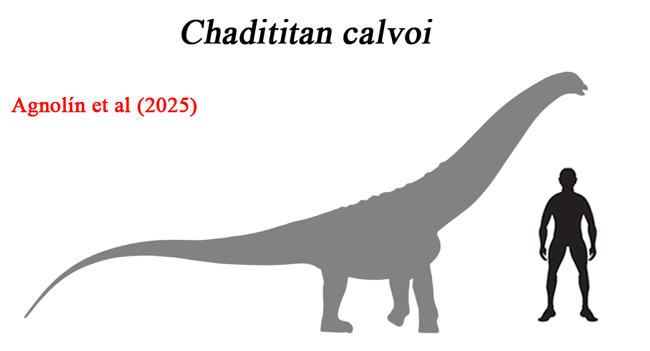A New Titanosaur from Northern Patagonia
A new species of rinconsaurian titanosaur has been named based on fossils unearthed in northern Patagonia. The dinosaur has been named Chadititan calvoi. The Rinconsauria clade comprises Late Cretaceous, relatively small and gracile Argentinian titanosaurs. Its composition remains disputed. Phylogenetic analyses reveal contrasting results depending on statistical parameters, but some academics have proposed as many as twenty taxa within this clade.
The fossil material, representing several individuals comes from outcrops of the Anacleto Formation. This formation is thought to have been laid down in the early to middle Campanian faunal stage of the Cretaceous. The bedding plane associated with these fossils suggests that this dinosaur lived around seventy-eight million years ago.
Chadititan calvoi
The genus name is derived from the local dialect meaning “salt”. The type locality is an extensive salt flat. The species name honours the Argentine palaeontologist Jorge O. Calvo who first proposed the Rinconsauria clade. Although known from fragmentary remains, palaeontologists have been able to estimate the size of this herbivore. The partial femora (thigh bones), were compared to more complete Bonatitan (B. reigi) limb bones. Chadititan is estimated to have been around seven metres long.

A scale drawing of the rinconsaurian titanosaur from northern Patagonia Chadititan calvoi. This dinosaur is estimated to have been about seven metres in length. Picture credit: Everything Dinosaur.
Picture credit: Everything Dinosaur
The Rinconsauria was erected in 2007. The clade consists of slender relatively small titanosaurs with long limbs and modified pelvic girdles. As far as we at Everything Dinosaur are aware, no osteoderms have been found in association with rinconsaurian fossils. Dermal armour could have been absent in this clade of titanosaurs.
A Diverse Fossil Assemblage Dominated by Freshwater Turtles
The fossils were found at a location owned by the Marin family near General Roca city (Rio Negro province). The authors of the scientific paper report a new assemblage of fossils representing a diverse biota. The site could represent an oasis in what was an exceptionally arid environment. Gastropods, lungfishes, freshwater turtles and crocodilian fossils have been found.
Turtle fossils are the most common vertebrate fossils present. They represent over ninety percent of the recovered material.
The scientific paper: “New fossiliferous locality from the Anacleto Formation (Late Cretaceous, Campanian) from northern Patagonia, with the description of a new titanosaur” by Agnolín, Federico L.; Motta, Matías J.; Garcia Marsà, Jordi; Aranciaga-Rolando et al. Paper published – Revista del Museo Argentino de Ciencias Naturales.
The award-winning Everything Dinosaur website: Dinosaur and Prehistoric Animal Models.

